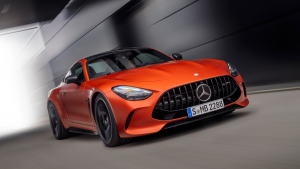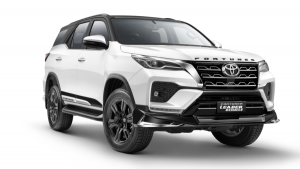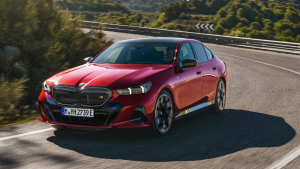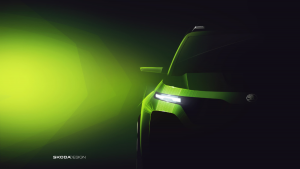The motorcycle boot buying guide
We have already brought you guides to help you choose motorcycle gloves and jackets for yourself. Now it's time to look at how you approach buying a good motorcycle boot.
Why do I need a motorcycle boot at all?
Falling off a motorcycle is not the same as going for a hike or trekking or indeed going for a run in an army boot camp. Indeed, not falling off a motorcycle is not like going for a hike, trekking or army boot camp either. You might think that the feet do little on the bike apart from changing gears and operating the rear brake. But the truth is, if you're riding right, your feet are also holding you to the bike, creating stability and much more. More to the point, when you fall off the bike, the boot has the unenviable job of protecting a vital, complex but relatively fragile arrangement of joints and bones.
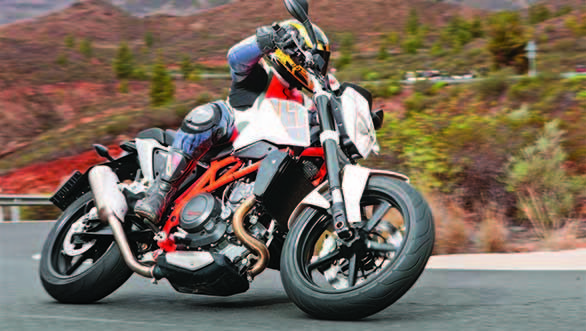
It goes about this in three ways. The first is impact protection. This is protection against your feet impacting the road or whatever you are crashing into at the time. Some form of armour or the other is needed to reduce the force that your foot has to deal with. The second is abrasion protection. This is protection from the loss of skin and tissue than happens when your skin and flesh are suddenly expected to slide along the road at speed - something they clearly weren't designed to do. To do this, the boot must have materials that resist abrasion as well as closure systems that keep the boot on your foot. Sneakers are singled out because even leather sneakers (some abrasion protection) have issues staying on your foot meaning the overall abrasion protection is effectively zero. Finally, there is hyperextension prevention. Hyperextension implies a joint being forced to move in a configuration it isn't designed to handle. Examples could be your toe stuck under the bike while you keel over backwards. On an impact that forces your instep up so that it comes into contact with your shin. Both are unnatural movements that are sure to cause structural damage. Motorcycle boots feature a number of systems that are designed to allow motion in the usual directions but not in other orientations. This can also make them uncomfortable for anything but on-motorcycle use.
Basic styles
Visually, motorcycle boots roughly fall into four categories. Sports boots feature sliders, armour, plastic moulding and other elements which gives them a loud, technical appearance. Subtle they rarely are and that isn't everyone's cup of tea. But these are also usually the most protective and most expensive of the lot. Casual or street boots feature some protection but it is kept low-key so that the outward appearance is of a casual shoe. These can be very comfortable off the bike in daily use but the protection levels have to be backed off to achieve both the casual look and the usually affordable to mid-range prices. Cruiser style boots take a whole different direction trying to blend protection into a retro-style leather boot. Fourth and final are other boots, including off-road and motocross boots that are rapidly evolving into niches and specialised boots. We aren't going to cover motocross boots in any great detail in this guide.
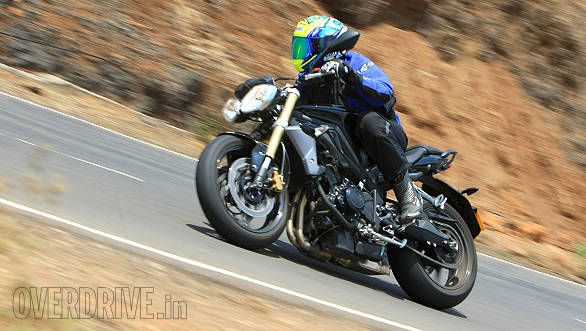
For our guide, the height of the boot is actually a bigger consideration than visual style. Roughly speaking there are three boot heights today. The basic is over the ankle. In fact, if your using any boots on the bike, you should make sure they are leather (more abrasion resistance), rise to above the ankle (protects ankle bone and less likely to slip off in a crash) and have a secure closure system (if it's a lace-up, then lace them up like you mean it).
Shorty boots
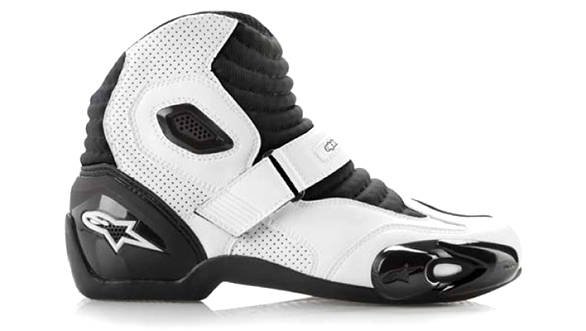 The 'shorty' refers to the height of the boot. Shorties rise to just above the ankle - which is the minimum height you want from a motorcycle boot. Over the ankle protects the exposed ankle bone as well as makes the shoe harder to dislodge during a crash
The 'shorty' refers to the height of the boot. Shorties rise to just above the ankle - which is the minimum height you want from a motorcycle boot. Over the ankle protects the exposed ankle bone as well as makes the shoe harder to dislodge during a crash
So the least protective boot, most likely to be a casual style is the shorty boot. There are casual and sporty styles now but these boots rise to just above the ankle. Which means the job of protecting your shin falls to your motorcycle trouser. It's not a trade-off I personally am comfortable with but I know a lot of people, including a few ex-colleagues who use shorty boots as their daily motorcycle boots.
Mid height boots
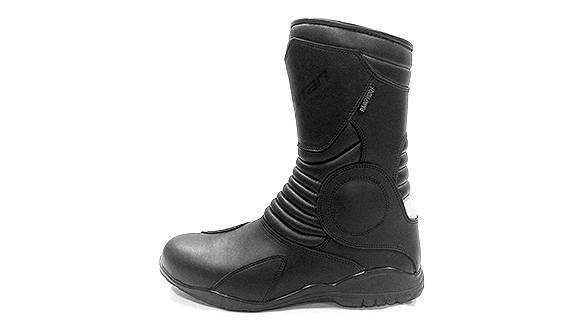 This is a mid-height boot which is a common style for touring boots that offer significant protection but without the size and inconvenience of a full-on knee-high boot
This is a mid-height boot which is a common style for touring boots that offer significant protection but without the size and inconvenience of a full-on knee-high boot
Then come the mid-height boots which rise to the middle of the shin. Most cruiser boots and touring boots use this configuration. The boots are very comfortable, easy to get in and out of and there is some protection without the bulk of a full height boot.
Full height boots
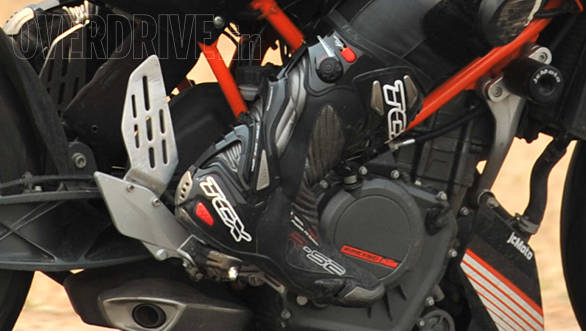 This is a full height boot. It rises pretty close to the knee and the overlap between the knee armour on the pant and the shin plate is significant. These boots are tall because they are the most protective of the motorcycle boots and the height, again, makes them nearly impossible to come off during a crash
This is a full height boot. It rises pretty close to the knee and the overlap between the knee armour on the pant and the shin plate is significant. These boots are tall because they are the most protective of the motorcycle boots and the height, again, makes them nearly impossible to come off during a crash
The full height boot rises to the bottom of the knee joint or thereabouts. It will usually feature a substantial armour (foam or more likely moulded plastic) that will cover the entire Tibia leaving an accordion-style panel to allow bending just above the ankle. The closure systems can vary but these boots are the hardest to get in and out of. You can get used to them, but wearing them everyday requires commitment.
Armour basics
For a good protective boot you should look for the following features:
1. Shank
A shank is usually metal and is inside the sole. It's a metal plate that is there to prevent your foot from flexing in a rotational motion. To understand this motion, hold all the fingers of your right hand with your left hand. And twist while keeping your wrist and forearm steady. The shank ensures that the front and the rear of the boot cannot rotate independently of each other.
2. Toe and heel cups
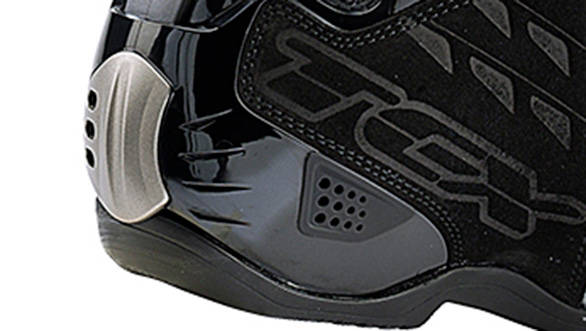 The external heel cup - this one has a metal slider element as well - is there to protect your heel from crushing forces and also allows the boot to slide along in a crash. If the boot catches on the road or something, the foot will have to bend or move to react, which is when you incur serious damage
The external heel cup - this one has a metal slider element as well - is there to protect your heel from crushing forces and also allows the boot to slide along in a crash. If the boot catches on the road or something, the foot will have to bend or move to react, which is when you incur serious damage
These cups come in various materials and they offer impact and crush protection. Many company uses internal cups (not visible) while others like to use internal armour and an external cup on the heel to allow the feet to slide along in a crash rather than catch and flip - which causes more damage.
3. Tibia plates
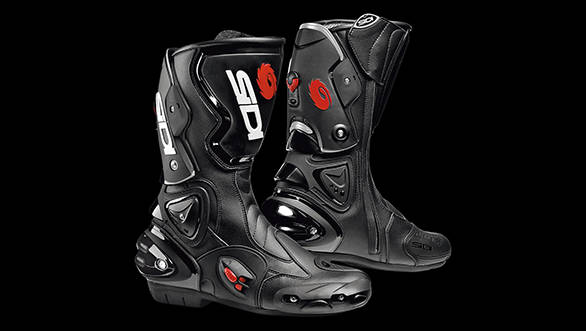 See the big logo on top of the boot? That's a shin or tibia plate that is usually moulded plastic put there to protect shin bones from impacts. Some boots offer foam versions but all are better than none
See the big logo on top of the boot? That's a shin or tibia plate that is usually moulded plastic put there to protect shin bones from impacts. Some boots offer foam versions but all are better than none
These plates usually cover the shin and add impact protection for times when something hits your shin area. They take various forms from foam armour (most touring boots) to plastic plates (race boots).
4. Hyperflexion prevention systems
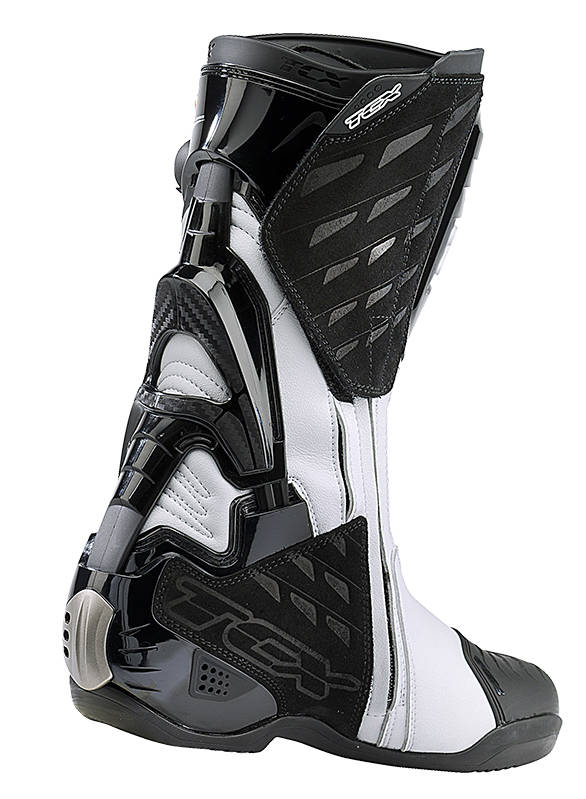 See all that plastic that runs from the heel to the top of the boot along the back? That's a system - each boot maker has his own - to allow the ankle joint to flex normally while preventing the joint from flexing backwards too far. Joints suffer structural damage when crash forces create movement beyond the natural angles
See all that plastic that runs from the heel to the top of the boot along the back? That's a system - each boot maker has his own - to allow the ankle joint to flex normally while preventing the joint from flexing backwards too far. Joints suffer structural damage when crash forces create movement beyond the natural angles
These usually cover the heel, Achilles' tendon and back of the calf muscle. They're complicated looking structures that allow you to bend the shin forward with the feet flat on the floor but restrict side-to-side and backward movement of the joint. Effective systems disappear on the bike but can make walking harder.
5. Sliders
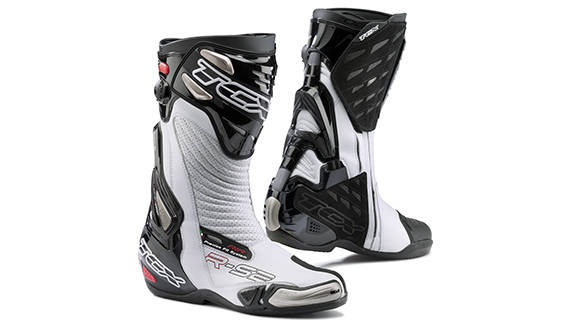 Race and sporty boots typically add sliders, usually replaceable, which is material in critical places where the boot might make contact with the road under normal cornering. These boots have a metal toe slider. If you look carefully, you will also see sliders on the ankle bone as well as on the shin plate
Race and sporty boots typically add sliders, usually replaceable, which is material in critical places where the boot might make contact with the road under normal cornering. These boots have a metal toe slider. If you look carefully, you will also see sliders on the ankle bone as well as on the shin plate
Sliders are more for abrasion resistance on the move than for crashes. They protect toes, ankle bones and the top of the boot from wearing out from contact with the road during high lean angles.
Closures systems
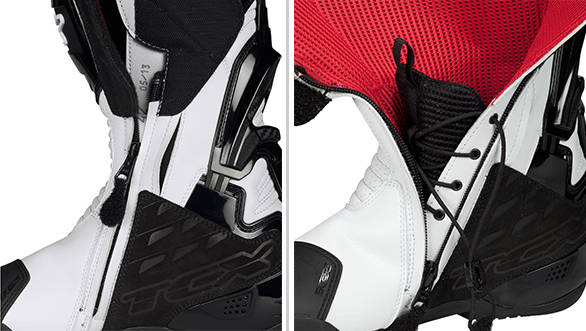 Because laces can get tangled, normal lacing isn't usually a motorcycle boot feature except for the lowest-end boots. Usually there is a zipper on the inside like in the pic with a velcro flap that closes off the boot. This is pretty easy to use. These particular boots allow the rider to make them fit better with an inner tongue and an internal lace system
Because laces can get tangled, normal lacing isn't usually a motorcycle boot feature except for the lowest-end boots. Usually there is a zipper on the inside like in the pic with a velcro flap that closes off the boot. This is pretty easy to use. These particular boots allow the rider to make them fit better with an inner tongue and an internal lace system
You get all kinds of closure systems from velcro straps and laces to velcro and zippers. Top race boots use an internal armoured boot (usually carbon fibre) that actually is covered by the outer boot (in leather or synthetic leather) that makes wearing these cumbersome but the protection levels are incredible. For our purpose we are looking for a closure system that doesn't take forever to use while ensuring the boot stays on the foot in a crash.
Fit
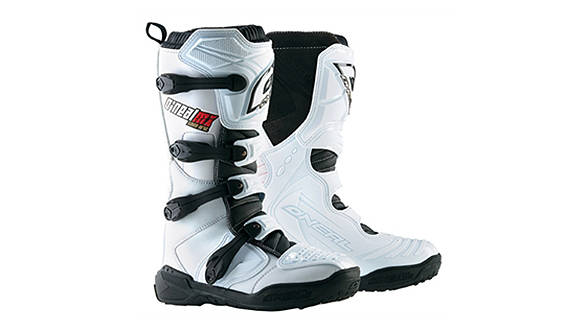 Boots should fit as snug as you can handle and feel like an extension of your foot on the motorcycle. Thicker soles last longer but can also rob you of feel. One thing to note is that because they have armour, motorcycle boots can take longer than normal boots to 'break-in' and they also flex and stretch less than normal so getting the fit right from the start is more important
Boots should fit as snug as you can handle and feel like an extension of your foot on the motorcycle. Thicker soles last longer but can also rob you of feel. One thing to note is that because they have armour, motorcycle boots can take longer than normal boots to 'break-in' and they also flex and stretch less than normal so getting the fit right from the start is more important
As usual, we are looking for a snug, comfortable fit. Armoured boots feel very different from normal footwear and you should realise that the armoured areas - like the toe-box and heel cup don't really loosen up over time. So pay extra attention to how these areas feel and whether you'll be comfortable in them. If you're going to be spending a lot of time off the bike in motorcycle boots, then, also see how easy it is to walk around in the boots you intend to buy. Be warned that hyperflexion systems usually rely on plastic-plastic contact and can be noisy and squeaky in daily use. In my case, I cannot walk into the office without various people looking up to see why there seems to be a creaky door in the office.
Materials
As usual, leather is best for abrasion resistance. Lorica, a kind of synthetic leather is also considered equally good and is perhaps even more stable once wet than natural leather. Waterproof boots can be made of leather but look for a waterproof membrane (like Gore-Tex) - that's what makes the boot waterproof. Casual styles can come in other materials but serious boots usually are leather or Lorica.
Waterproofing
Nothing is fully waterproof. Waterproof boots should have a membrane, be tall (so there isn't a gap between trouser and boot for the water to get in) and the the zipper closure should have a sealed folding back to prevent water ingress.
How to choose a boot?
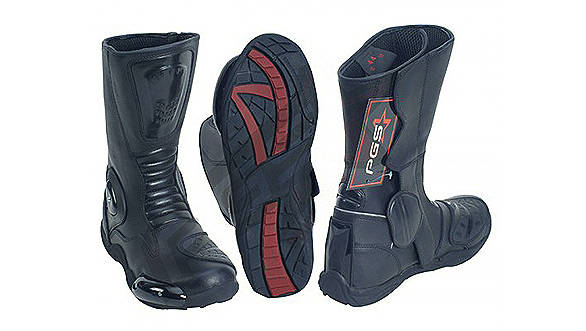
A large chunk of your decision will be based on your budget. But think about what you are going to use it for. Touring styles usually make the best all-round boots but the waterproof ones can be too warm to use daily. If wearing them with office trousers is a consideration then you'll have to look at more restrained styles. The big decision is whether you're okay with a shorty or want full height boots. The latter are unrivalled in protection terms but you'll have trouble wearing them off the bike, under denims and stuff.
What about non-motorcycle boots?
Avoid. But if you must, stay away from sneakers. Get a leather boot that goes above your ankle with a solid closure system at the very minimum.
Should I buy these online?
Ideally no. But in India you may not have a dealer located conveniently enough. The armour makes motorcycle boots very specific in feel and not very flexible in fit. It's best to go and try it before you buy it.
Also see our comprehensive list of the best motorcycle boots, jackets and gloves to buy within a budget.
Related Stories
Top Stories
Latest Videos
Most Popular
- Budget Sportbike Showdown: Kawasaki Ninja 500 vs Aprilia RS 457 vs Yamaha YZF-R3
- 2014 Triumph Daytona 675 vs 2024 Kawasaki ZX6R - A Decade of Evolution in Supersport Motorcycles
- Mumbai-Pune Expressway speed restrictions updated
- Nissan Magnite EZ-Shift review - is the AMT any good?
- Nitin Gadkari states that tax on Hybrids should be reduced to 12 percent in the coming future
